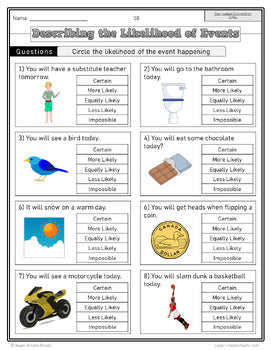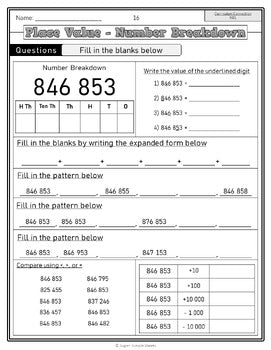Nova Scotia Grade 5 Math - Full Year Bundle
Nova Scotia Grade 5 Math - Full Year Bundle
Interested in a bundle? Shop below instead!
Couldn't load pickup availability
PRODUCT PREVIEW
BOTH DIGITAL AND PDF VERSIONS INCLUDED!
Nova Scotia 2022 Math Curriculum - Grade 5 – This resource covers all outcomes and indicators in the Grade 5 - Nova Scotia 2022 Math Curriculum.
There are 955+ activity sheets for your students to learn and practice the outcomes and indicators in the curriculum. Using this resource will ensure that your students will be learning the Nova Scotia curriculum.
Distance Learning made easy! GOOGLE CLASSROOM VERSION - PDF INCLUDED! This gives you the ability to print worksheets as well as distribute a digital copy of the resource to your students on Google Classroom.
Check out each of the strands below to learn more about the resources included in this bundle.
Number Strand
Concepts that are covered:
- Place value of numbers up to 1 million
- Expanded form and expanded notation
- Written form and standard form of numbers up to 1 million
- Numbers in our lives up to 1 million
- Comparing numbers
- Place value of decimals to the thousandths place
- Comparing decimals
- Writing decimals using words
- Expanded form of decimal numbers
- Counting by decimals
- Ordering decimals
- Writing decimal numbers on a number line
- Estimating numbers – rounding, front-end estimation, clustering
- Converting fractions to decimals
- Multiplication – mental math strategies (skip counting, distributive property, doubling and halving)
- Multiplication – 2 digit by 2 digit
- Word problems – up to 2 digit by 2 digit
- Multiplying by multiples of 10
- Multiplying – area model
- Estimating products using round numbers and multiples of ten
- Division – skip counting and splitting up the dividend
- Division – 3 digit by 1 digit, area model
- Estimating quotients
- Adding and subtracting decimals – mental math strategies
- Adding and subtracting money – decimals
- Making change – word problems involving adding/subtracting decimals
- Comparing fractions
- Equivalent fractions
- Ordering and comparing fractions with common numerator or common denominator
- Comparing and ordering fractions using equivalent fractions
- Simplifying fractions
- 4 Unit tests
- Answer pages for all activities
Patterns and Relations
Some of the concepts that are covered:
- Extending increasing addition and multiplication patterns
- Pattern rules of increasing patterns
- Extending decreasing subtraction and division patterns
- Pattern rules of decreasing patterns
- Determining the missing value in different sequences using all operations
- Table of values
- Translating geometric and numeric patterns into tables of values
- Finding the value of an unknown term in a pattern
- Representing a pattern using a mathematical expression (n + 1 or 2n)
- Word problems – representing a word problem in a table of values
- Finding the nth term in a pattern using an expression
- Expression or equation?
- What are equations?
- Writing equations that represent a situation
- Finding the unknown number in an equation
- Is an equation balanced or unequal?
- Determining matching equations
- Express the product of a number and a variable using a coefficient (ex. 5n)
- Express the quotient of a variable and a number as a fraction.
- Solving word problems using equations to represent the problem
- 2 Unit Tests
- Answer pages for all activities
Measurement and Geometry
Some of the concepts that are covered:
- Measuring in centimetres, millimetres, and metres
- Converting units – centimetres, millimetres, and metres
- Using referents with metric units
- Estimating the length of different objects
- Measuring the perimeter of shapes
- Calculating the perimeter of polygons
- Calculating the area of rectangles
- Comparing the area and perimeter of rectangles
- Drawing rectangles with given perimeters and areas
- Finding the missing side length when given the area of a rectangle
- Perimeter and area word problems
- Volume of a rectangular prism – counting blocks
- Using a formula to calculate volume
- Volume word problems
- Metres cubed versus centimetres cubed – referents
- Capacity of containers – mL and L
- Experiment - measuring capacity
- Converting units – mL and L
- Comparing units – mL and L
- Lines – perpendicular, parallel, intersecting, horizontal and vertical
- Labelling lines in polygons
- Quadrilaterals – naming different types
- Labelling lines in quadrilaterals
- Attributes of different quadrilaterals
- Transformations – rotations, reflections, and translations
- Performing transformations
- Turns – clockwise and counterclockwise as well as angles
- Identifying the type of transformation
- Right angles and angles less than and greater than right angles
- Finding angles in the classroom
- Finding angles in everyday life
- 4 Unit Tests
- Answer pages for all activities
Statistics and Probability
Some of the concepts that are covered:
- What is a population?
- How to sample a population properly
- First-hand data and second-hand data
- Creating first-hand survey questions
- Creating second-hand survey questions
- Surveying classmates to collect first-hand data
- Collecting second-hand data about areas of interest
- One-to-one correspondence versus many-to-one
- How to determine the scale of a graph
- Review: reading a bar graph
- Double-bar graphs
- Collecting data for double bar graphs
- Creating a double bar graph
- Misleading graphs – different scales
- Certain or impossible?
- Describing probability – certain, possible, impossible
- Describing probability – certain, likely, equally likely, unlikely, impossible
- Using a probability line
- Performing probability experiments – coin flips and rolling a dice
- 2 unit tests – statistics and probability
This is a comprehensive bundle that will save you hours of planning! It has been tested and found effective in helping students achieve the learning outcomes outlined in the Nova Scotia 2022 curriculum.
Answer pages for all slides/sheets are included!
Share













